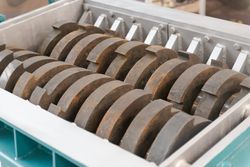What Happens to Cars at Salvage Yards?

Junk cars are made of many reusable materials that would end up in landfills if it wasn't for auto salvage yards. These facilities pay owners for their unwanted cars, and then put the vehicles through a recycling process that yields very little waste. Use this helpful guide to learn more about what happens to cars at a junkyard.
4 Steps of Junk Car Recycling
1. Dismantling
Junk cars are first dismantled, and all parts that can be recycled—including the tires, battery, trim, and other removable items—are detached. This essentially makes the vehicle an immobile, metal shell.
2. Draining
All fluids are drained and safely disposed of or recycled. This includes engine oil, transmission oil, brake fluid, power steering fluid, and washer liquid.
Many of these fluids are toxic and could poison the soil, contaminate groundwater and aquifers, kill wildlife, or otherwise damage the environment if they’re not handled properly.
3. Crushing & Shredding
 The car is then crushed into a 3- to 5-foot square cube. This makes it more convenient to handle until the cube is subsequently run through a shredder. The crushed vehicle leaves the shredder as hundreds of tiny pieces of metal.
The car is then crushed into a 3- to 5-foot square cube. This makes it more convenient to handle until the cube is subsequently run through a shredder. The crushed vehicle leaves the shredder as hundreds of tiny pieces of metal.
4. Sorting & Recycling
The metal shards are then sorted with a huge magnet into ferrous (or iron-based) and non-ferrous metals, such as copper, zinc, brass, aluminum, and aluminum alloys.
These are then recycled into raw materials for manufacturing and are later transformed into everyday products, from staplers and cooking foil to construction hardware.
If you have a junk car that has reached the end of its useful life, contact Rudy's Towing & Auto Salvage in Philadelphia, PA. These professionals offer junk car removal and pay top dollar for scrap. They are open seven days a week and serve clients throughout Bucks and Montgomery counties. Learn more on the website or call (267) 235-9421 to get cash for your junk car.
About the Business
Have a question? Ask the experts!
Send your question

